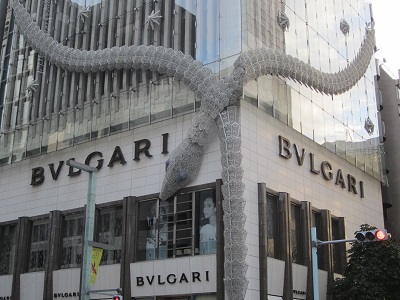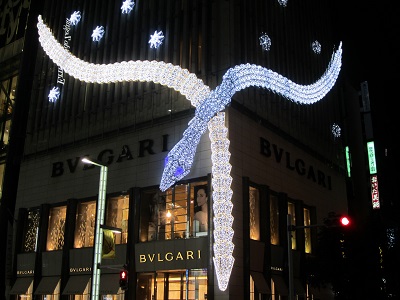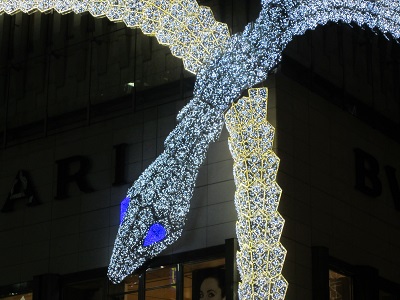List of Authors
>>About this blog
Recent blog post
|
[CAM]
Nov. 16, 2015 08:00
Today (November 14), a correspondent off party was held at a certain izakaya in Ginza and attended.
At that table, it became a topic of the attending woman and Shima Iwashita, and I wrote a work called "Aki Hiyori" by Yasujiro Ozu, but when I examined it again, Shima Iwashita played the heroine It was "Taste of Sword Fish" (1962). Ozu's work does not have a special story for each work, so the title and content do not come out immediately.
![71bm-TetdgL._SX522_[1]. jpg](https://en.tokuhain.chuo-kanko.or.jp/archive/71bm-TetdgL._SX522_%5B1%5D.jpg)
"Taste of Swordfish" is a depiction of the relationship between the elder father who preceded his wife and the married daughter, along with the theme of "old" and "loneliness" of the father who married her daughter. Director Ozu died in 1963, the year after the announcement of this work, and this work became a masterpiece.
Morinaga's spherical advertising tower appears only to show that the bars and small restaurants that appear exist in the Ginza area, but if so, I think we should take a closer look at the scenery of Ginza.
In "Autumn weather" (1960), Setsuko Hara and Shibako are heroines. Shima Iwashita has appeared in the role of a fool, but it seems that he was found in Ozu in this work and was selected as the heroine of "Taste of Sword Fish". The cut of Kiyosu Bridge comes out twice. It's a moment and a part, but I wanted you to include the whole view. Like Ginza in "Taste of Swordfish", isn't it Ozu's principle that does not clearly capture the geographical background of the scene? I'm wondering.
![51XFtCX2joL._AC_UL115_[1]. jpg](https://en.tokuhain.chuo-kanko.or.jp/archive/51XFtCX2joL._AC_UL115_%5B1%5D.jpg)
Shima Iwashita in "Taste of Sword Fish" (1962) is also beautiful, but Mariko Okada, who appears in both works, is also young and charming.
[Dimini ☆ Cricket]
Nov. 15, 2015 18:00
[Sam]
Nov. 15, 2015 09:00
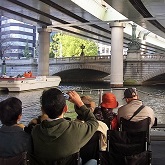  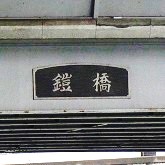
"Chuo-ku Marugoto Museum 2015" held on November 1st.
One of the popular events is the “ship operation” where you can enjoy the rich waterside and waterside of Chuo-ku on a free ship.
①In addition to the Nihonbashi tour route, (2) the Akashicho waterside line tour route, (3) the Hamacho / Harumi route, and (4) the Nihonbashi / Harumi route are organized, but the Nihonbashi tour route is particularly easy.
With the Nihonbashi Pier at the departure and departure point, turn back at Nihonbashi-Edobashi-Amiribashi-Kayababashi, and return again at Nishikawabashi Bridge. Until around 40 (planned) about 1 flight every 15 minutes from any time.
Wear a belt-type life jacket and enjoy the appearance of the neighborhood that retains the remnants of Edo from a different river surface guided by the river guide.
One of the real pleasures of river cruises is that you can enjoy the modeling behind the bridge that you can't usually see.
The structure of "Edobashi", in which the rivets are packed in a row, is spectacular and you can feel the profound beauty of modeling.
Recently, it seems that paint writing on the side has increased, but the nameplates of "Armor Bridge" and "Nishikawabashi Bridge" from the line of sight from the ship are still tasteful.
It's a time to learn more about the historical waterside assets.
[CAM]
Nov. 14, 2015 18:00
When I worked as a guide on a bus route at the Marugoto Museum the other day, "In the old days, both Kanda and Shiba were not Edo. Of course, Asakusa was also outside Edo, "Is it true?"
In this regard, I posted before, but I will post it again.
Mr. Yasaburo Ikeda stated as follows:
>Historically, if the Edo kid was born in the town of Edo under the shogun's knee, the people in the former Nihonbashi and Kyobashi wards of Chuo-ku are the center of this. In the very old days, both Kanda and Shiba were not Edo. Of course, Asakusa is also outside Edo. However, with the times, those who were born in Shiba and grew up in Kanda have also become Edokko, and the head office Fukagawa facing the river has entered Edo. (Nihonbashi Private Note 88)
>The original Edo kid was supposed to have been the people who worked mainlygiboshi and giboshi in the former Nihonbashi and Kyobashi wards in Chuo-ku. Since then, it has gradually been included even people born and lived in Kanda, Shiba, and Honjo Fukagawa.
>In addition to the husbands of the merchants of "Honmachi" in Edo, the number of people belonging to the craftsman class increased, forming Edokko. Therefore, even if you preach the temperament about money, when targeting people who belong to the class of merchants, mainly in Honmachi in Edo, you must find the temperament of those who have stored dignifiedly, rather than not using the money of the evening. Must. It is dangerous to bring out the temperament from Edokko, a concept that appears in the world of lectures and rakugo. (Nihonbashi Private Note 88)
Yasaburo Ikeda (1914-1982). Born in Ginza, Kyobashi-ku, Tokyo. Graduated from Kyobashi Ward Yasuaki Elementary School, Faculty of Letters, Keio University. He appeared on NHK's TV program and was also known as a talent professor.
[CAM]
Nov. 14, 2015 14:00
As I posted earlier, the photo of Asahi Inari Shrine (Ginza 3-8-12) was not uploaded, so I will list it again independently.
As for Asahi Inari Shrine, as described on page 51 in the Monoshiri Encyclopedia, visits to worship hall on the ground are designed to reach main hall on the roof of the building through pipes.
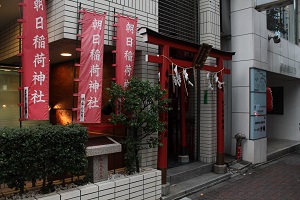
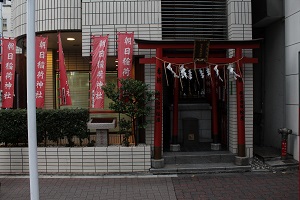

Asahi Inari Shrine's Engi
"Asahi Inari Shrine has been enshrined here since ancient times, has been deeply worshiped as a guardian deity, and has attracted distant reverence. However, since the collapse of shrine hall by the major earthquake of Ansei and the death of Sansankenbori, the shrine was devastated and scattered near the wanders.
In 1917, the spirit became apparent from Sanju-bori by the Great Kaisho that hit Ginza, and Tateoka, the architect, served here, but was forced to relocate due to the Great Kanto Earthquake, and the shrine was relocated to the Ginza Sanchome Town Association. It was a place to serve. All the worshipers in the town feared the god of religion and tried to serve as guardian angel in the town, but at that time the company land was incorporated into Tokyo-owned land and was governed by Tokyo City. The reverence of 3-chome visited the assistant of Tokyo City at the time and asked for Shimotsuki of the company grounds, but did not come true. However, with the permission of the use of the land, the shrine was erected and the company land was prepared. The first day was celebrated grandly, and the fair gathered many people in the same way as guardian of children and travelers's success in 4-chome. As such a guardian deity in the town, shrine hall all returned to Karasuari because of the war.
After the war, shrine hall was rebuilt and became a religious corporation Asahi Inari Shrine in 1952. Since then, he has been rehabilitated by the Sanchome Neighborhood Association, and his deity has become even more widespread and has given protection to those who believe.
In 1983, along with the renovation of the neighboring Ohiro Building, we started building a joint building. The first and second floors of a part of the building were worship hall and main hall was laid on the roof, but the pipes were designed to connect to the earth and reach worship hallmain hall. It became a shrine suitable for the land of Ginza ahead of the times.
Every year at the first noon, the festival is held grandly, and at the time of the Great Ginza Festival, it attracts the reverence of many people, not just Ginza 3-chome, as a billboard for visiting Ginza Hatcho Shrine.
It is not only prosperous as a god of commerce, but also has no fire since he was enshrined here, and there is no danger of marriage and harmony in the house.
1988 Ginza 3-chome Town Association
main hall on the roof of the building
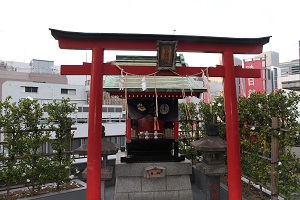
[CAM]
Nov. 14, 2015 12:00
It's sunny today (November 3). The last day is "Ginza Hatcho Shrine Tour 2015", which will be held from November 1st to 3rd.
I'm going around the five companies I left yesterday. First of all, "Ginza Ise guardian of children and travelers" (Ginza 4-6) on the rooftop of Mitsukoshi.
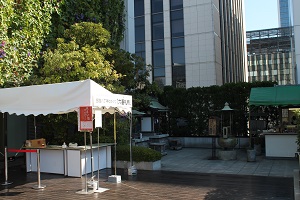
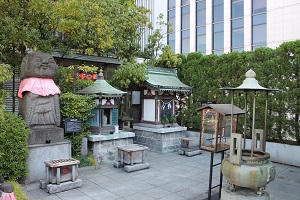
"Ko Inari Shrine" (Ginza 1-5, Namiki-dori St. 1-chome)
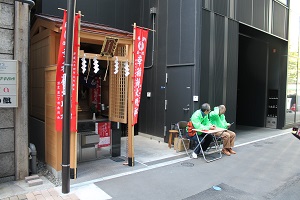
Ginza Inari Shrine (Ginza 2-6, Ginza Gaslight Street)
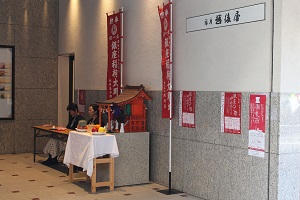
Ryuko fudoson (Ginza 3-6) on the roof of Matsuya
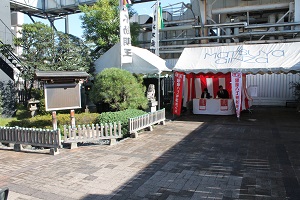
"Asahi Inari Shrine" (Ginza 3-8)
|
Links
|
![71bm-TetdgL._SX522_[1]. jpg](https://en.tokuhain.chuo-kanko.or.jp/archive/71bm-TetdgL._SX522_%5B1%5D.jpg)
![51XFtCX2joL._AC_UL115_[1]. jpg](https://en.tokuhain.chuo-kanko.or.jp/archive/51XFtCX2joL._AC_UL115_%5B1%5D.jpg)
